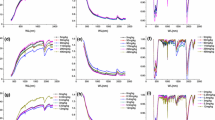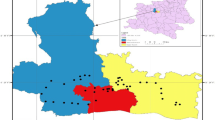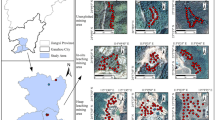Abstract
In near-infrared spectroscopy, the traditional feature band extraction method has certain limitations. Therefore, a band extraction method named the three-step extraction method was proposed. This method combines characteristic absorption bands and correlation coefficients to select characteristic bands corresponding to various spectral forms and then uses stepwise regression to eliminate meaningless variables. Partial least squares regression (PLSR) and extreme learning machine (ELM) models were used to verify the effect of the band extraction method. Results show that the differential transformation of the spectrum can effectively improve the correlation between the spectrum and nickel (Ni) content. Most correlation coefficients were above 0.7 and approximately 20% higher than those of other transformation methods. The model effect established by the feature variable selection method based on comprehensive spectral transformation is only slightly affected by the spectral transformation form. In five types of spectral transformation, the RPD values of the proposed method were all within the same level. The RPD values of the PLSR model were concentrated between 1.6 and 1.8, and those of the ELM model were between 2.5 and 2.9, indicating that this method is beneficial for extracting more complete spectral features. The combination of the three-step extraction method and ELM algorithm can effectively retain important bands associated with the Ni content of the soil. The model based on the spectral band selected by the three-step extraction method has better prediction ability than the other models. The ELM model of the first-order differential transformation has the best prediction accuracy (\({\text{R}}_{P}^{2}\) = 0.923, RPD = 3.634). The research results provide some technical support for monitoring heavy metal content spectrum in local soils.





Similar content being viewed by others
References
Achary MS, Satpathy KK, Panigrahi S, Mohanty AK, Padhi RK, Biswas S et al (2016) Concentration of heavy metals in the food chain components of the nearshore coastal waters of Kalpakkam, southeast coast of India. Food Control 72:232–243
Chakraborty S, Weindorf DC, Deb S, Li B, Paul S, Choudhury A et al (2017) Rapid assessment of regional soil arsenic pollution risk via diffuse reflectance spectroscopy. Geoderma 289:72–81
Chang C, Laird DA, Mausbach MJ, Chang CW et al (2001) Near infrared reflectance spectroscopy-principal components regression analyses of soil properties. Soil Sci Soc Am J 65(2):480–490
Chen T, Chang Q, Clevers JGPW et al (2015) Rapid identification of soil cadmium pollution risk at regional scale based on visible and near-infrared spectroscopy. Environ Pollut 206:217–226
Choe E, Meer FVD, Ruitenbeek FV, Werff HVD, Smeth BD, Kim KW (2008) Mapping of heavy metal pollution in stream sediments using combined geochemistry, field spectroscopy, and hyperspectral remote sensing: a case study of the rodalquilar mining area, se spain. Remote Sens Environ 112(7):3222–3233
Clark RN, King TVV, Klejwa M, Swayze GA, Vergo N (1990) High spectral resolution reflectance spectroscopy of minerals. J Geophys Res Solid Earth 95(B8):12653–12680
Guo W, Shang L, Zhu X, Nelson SO (2015) Nondestructive detection of soluble solids content of apples from dielectric spectra with ann and chemometric methods. Food Bioprocess Technol 8(5):1126–1138
Jiang Z, Yang Y, Sha J (2017) Application of GWR model in hyperspectral prediction of soil heavy metals. Acta Geogr Sin 72(3):533–544
Jing T, Wei HZ, Yun NZ et al (2016) Spectral response and inversion models for prediction of total copper content in soil of Xifanping mining area. Spectrosc Spectr Anal 36:3637–3642
Liu Y, Li W, Wu G, Xu X (2011) Feasibility of estimating heavy metal contaminations in floodplain soils using laboratory-based hyperspectral data: a case study along Le'an river, china. Geo-spat Inf Sci 14(1):10–16
Moros J, Vallejuelo FOD, Gredilla A, Diego AD, Guardia MDL (2009) Use of reflectance infrared spectroscopy for monitoring the metal content of the estuarine sediments of the Nerbioi-Ibaizabal river (Metropolitan Bilbao, Bay of Biscay, Basque Country). Environ Sci Technol 43(24):9314–9320
Pandit CM, Filippelli GM, Li L (2010) Estimation of heavy-metal contamination in soil using reflectance spectroscopy and partial least-squares regression. Int J Remote Sens 31(15):4111–4123
Pu W, Sun J, Zhang F et al (2019) Effects of copper mining on heavy metal contamination in a rice agrosystem in the Xiaojiang River Basin, southwest China. Acta Geochim. https://doi.org/10.1007/s11631-019-00321-5
Ramachandran KM, Tsokos CP (2015) Chapter 8: linear regression models. Math Stat Appl R 9(1–3):409–458
Rossel RAV, Walvoort DJJ, Mcbratney AB, Janik LJ, Skjemstad JO (2006) Visible, near infrared, mid infrared or combined diffuse reflectance spectroscopy for simultaneous assessment of various soil properties. Geoderma 131(1–2):59–75
Shi T, Chen Y, Liu Y, Wu G (2013) Visible and near-infrared reflectance spectroscopy-an alternative for monitoring soil contamination by heavy metals. J Hazard Mater 265C(2):166–176
Shrivastava NA, Panigrahi BK (2014) A hybrid wavelet-elm based short term price forecasting for electricity markets. Int J Electr Power Energy Syst 55:41–50
Tang Y, Han G (2017) Characteristics of heavy metals in soils under different land use in a typical karst area, southwest China. Acta Geochim 03:165–168
Wang J, Tiyip T, Ding J, Zhang D, Liu W (2016) Estimation of desert soil organic carbon content based on hyperspectral data preprocessing with fractional differential. Trans Chin Soc Agric Eng 32(21):161–169
Wold S, Sjöström M, Eriksson L (2001) Pls-regression: a basic tool of chemometrics. Chemom Intell Lab Syst 58(2):109–130
Wu Y, Chen J, Ji J, Gong P, Liao Q, Ma H (2006) Visible and near infrared reflectance spectroscopy for measuring soil heavy metal content as a quick method. Acta Geochim 25(s1):225–226
Xu Binbin LDX (1995) A preliminary study on identification of clay minerals in soils with reference to reflectance spectra. Pedosphere 5(2):135–142
Zhang L, Wu Y, Liu S, Zhou L, Cai D (2015) Research on monitoring of Pb content in the sewage irrigation area of Longkou city using hyperspectral data. Environ Eng 33(8):114–117 (in Chinese)
Zhang Q, Zhang H, Liu W, Zhao S (2017) Inversion of heavy metals content with hyperspectral reflectance in soil of well-facilitied capital farmland construction areas. Trans Chin Soc Agric Eng 33(12):230–239
Zhu QY, Qin AK, Suganthan PN, Huang GB, Patcog J (2005) Evolutionary extreme learning machine. Pattern Recogn 38(10):1759–1763
Acknowledgements
This research work was supported jointly by the National Key Research Program of China (Nos. 2016YFC0502102, 2016YFC0502300), “Western light” talent training plan (Class A), Chinese academy of science and technology services network program (No. KFJ-STS-ZDTP-036) and international cooperation agency international partnership program (Nos. 132852KYSB20170029, 2014-3), Guizhou high-level innovative talent training program “ten” level talents program (No. 2016-5648), United fund of karst science research center (No. U1612441), International cooperation research projects of the national natural science fund committee (Nos. 41571130074, 41571130042), Science and Technology Plan of Guizhou Province of China (No. 2017–2966).
Author information
Authors and Affiliations
Corresponding author
Rights and permissions
About this article
Cite this article
Lu, Q., Wang, S., Bai, X. et al. Rapid estimation of soil heavy metal nickel content based on optimized screening of near-infrared spectral bands. Acta Geochim 39, 116–126 (2020). https://doi.org/10.1007/s11631-019-00357-7
Received:
Revised:
Accepted:
Published:
Issue Date:
DOI: https://doi.org/10.1007/s11631-019-00357-7




